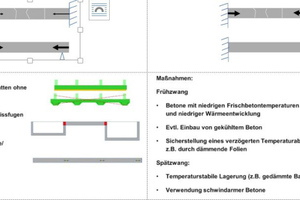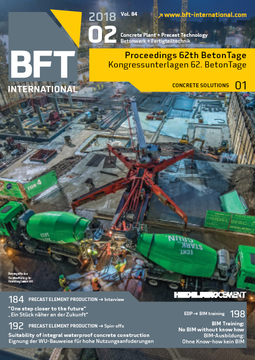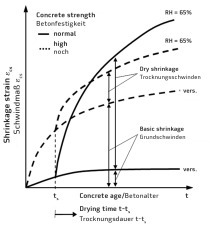Critical notes on various construction methods
Implementation of Design Principles a) and c) of the new WP Guideline on Water-Impermeable Concrete Structures [1] calls for rethinking the structural design involved, extending from pure dimensioning work and proceeding to design engineering, and to making allowance for restraint deformation. The planners, by specifying measures involving structural engineering, concrete systems, and technical execution, must prepare specifications that prevent or significantly reduce restraint cracks. Designing with low restraint signifies prevention or reduction of restraint deformation such that the restraint forces at a given time do not exceed the tensile strength of the concrete at any point in time. In this context, a distinction must be made between early and late constraint.
The examples in [2] are executed measures involving structural engineering, concrete systems, and technical execution, as presented in Design Principles a) and c).
Reduction of restraint deformations can be achieved either by preventing fixed points and restraints by means of structural measures, or by reducing indirect deformation-inducing effects by measures involving concrete technology and technical execution.
In practice, in particular ground slabs without offsets and temperature routes have especially proved successful as structural measures because they prevent the crack-inducing lateral-strain restraints that otherwise lead to cracking in the construction joints. Covering the members with heat-retaining insulation mats in winter and in summer has been used with good success, since this measure retards dissipation of the heat of hydration and maintains the temperature gradient at a low level, and the concrete experiences a noticeable increase in strength during its initial days.
For high-quality utilization of WP tanking or ground slabs in underground garages, various planners (architects and structural engineers) and experts recommend placement of an additional fresh-concrete composite system (FBVS). These are single-layer film systems that, via a bonded adhesive and/or mechanical connecting layer, are designed to form a durable bond over the entire surface of the concrete [3]. Although ABPs are available for the systems currently available on the market, their use – especially in practice – reveals that no sufficient bond over the entire surface can be reliably achieved and that this cannot be expected under the conditions that actually prevail. In addition, effort and costs equivalent to the use of sealing systems on the basis of prevailing standards are not at present being observed. The concrete composite film systems, as confirmed in [4], do not yet correspond to the accepted rules of good engineering practice. They are not mentioned in the new National Sealing Standard DIN 18533, nor in the new WP Code of Practice [1]. The claims ratio is considerable, because in the projects executed with composite film systems, additional injection work has been required to close water-bearing cracks and other weak points, or it was necessary to re-expose and repair the composite film system. Experts recommend, for example, WP ground slabs, designed for WP tanking, for use in underground garages, as follows:
Composite fresh-concrete system
WP ground slab as per Design Principle b), with crack width wcal = 0.1 – 0.15 mm, designed for early and late restraint
Design variety C1, according to DBV Code of Practice entitled “Parking Structures and Underground Garages” (underflow-proof sheeting and mastic asphalt) [5]
Recommendations in this context:
The constructional arrangement does not satisfy the accepted rules of good engineering practice. Design Principle b) imakes no sense when applied in conjunction with a composite fresh-concrete system, since this principle is intended for self-healing of the cracks. Requisite for this, however, is water flowing through the separating cracks, which the composite fresh-concrete system, at least by design, precludes. Under the assumption that the fresh-concrete composite film system (FBVS) is not fully sealed and that the water that flows through the separating cracks is expected to enable self-healing of the cracks, this is prevented by the sheeting: i.e., because it completely blocks CO2 from the air, which is required for self-healing. If water collects beneath the sheeting from the water that flows through the separating cracks, then it must be assumed that the sheeting will be separated from the concrete, since prevention of underflow is possible only through the action of pressureless chloride-containing water that results from utilization. Building damage thus follows by design and is preprogrammed. Irrespective of this, a construction of this kind is extremely uneconomical and provides no benefits of any kind in terms of additional reliability.
Accessibility of the surface of the WP ground slab should be the primary objective to provide for subsequent and simple reliable sealing of any waterbearing cracks that could materialize.








